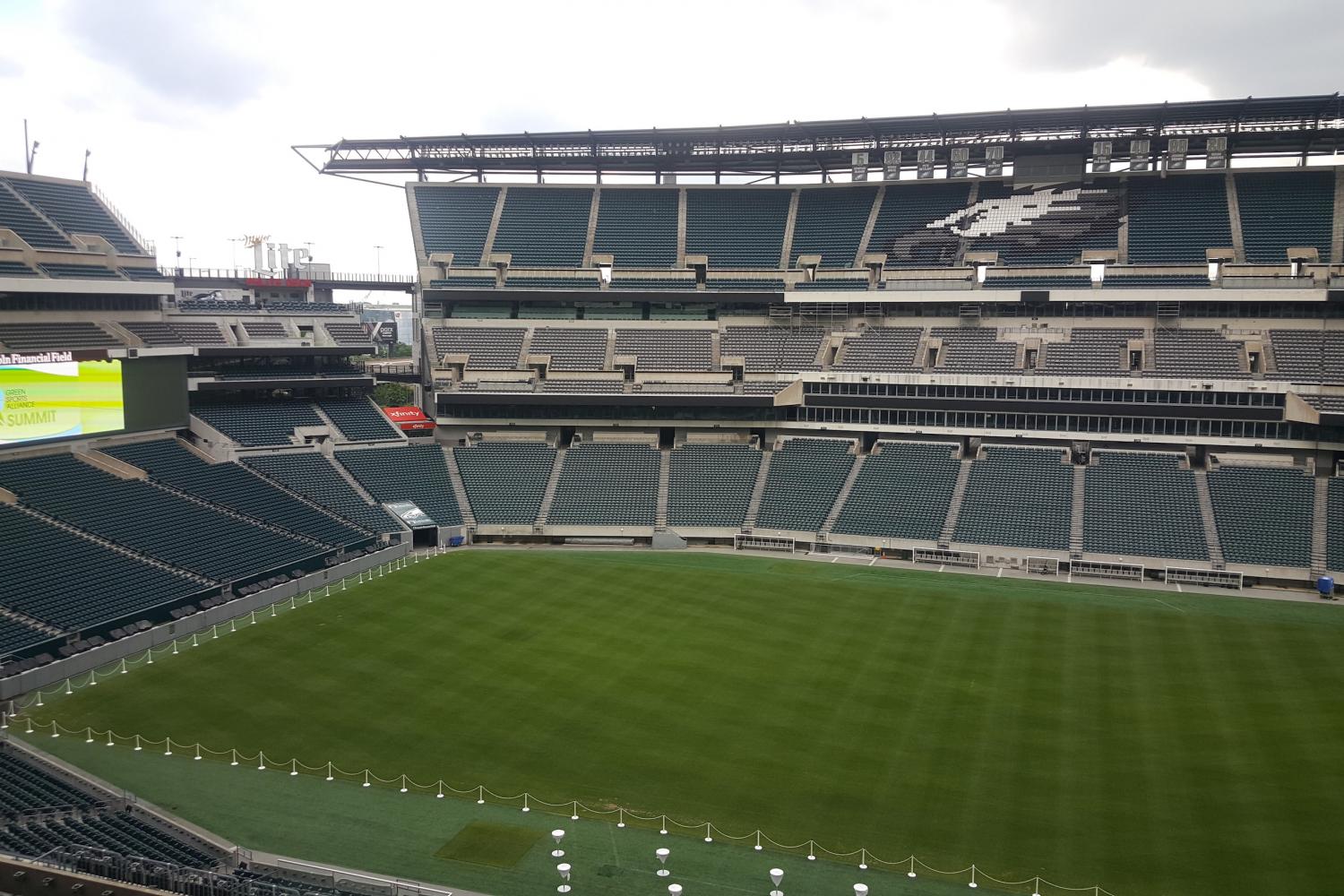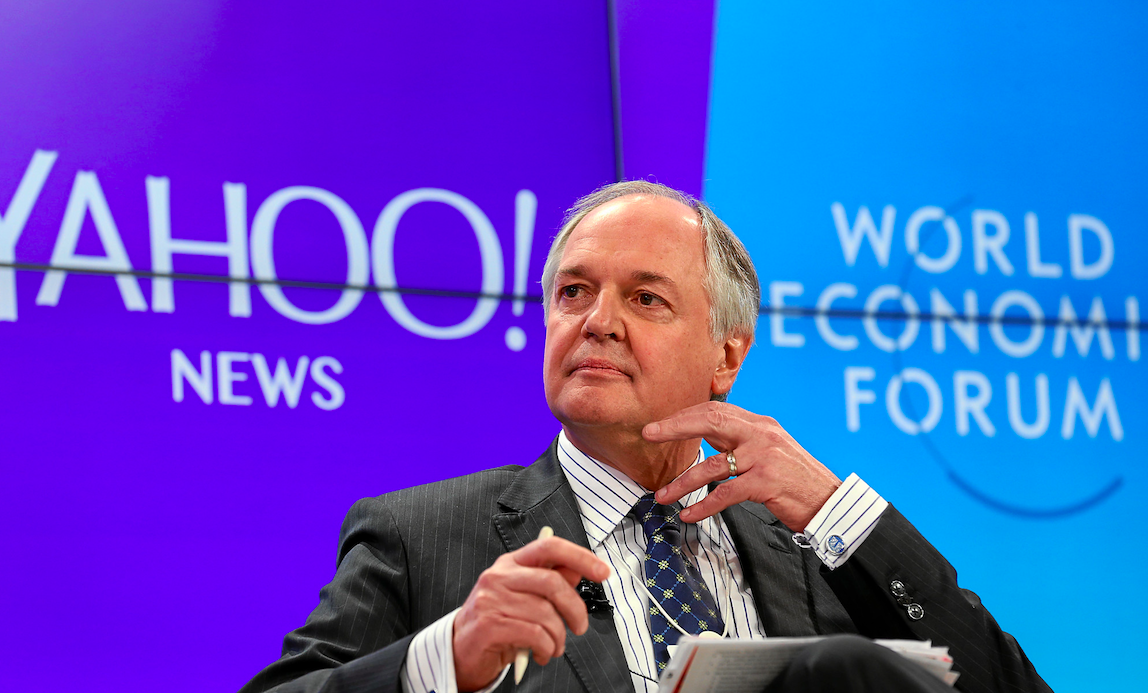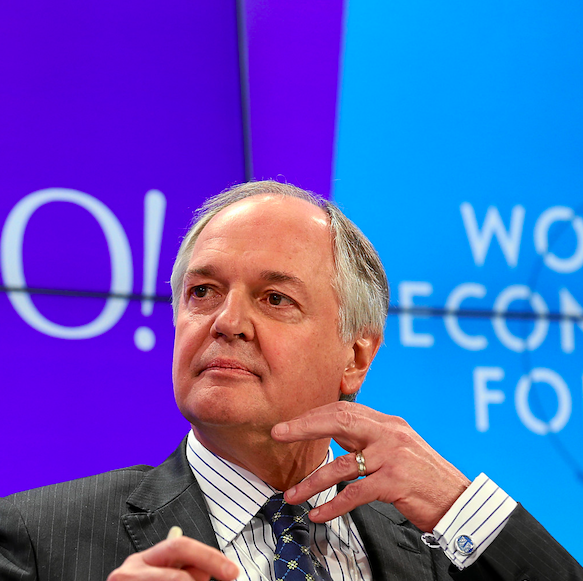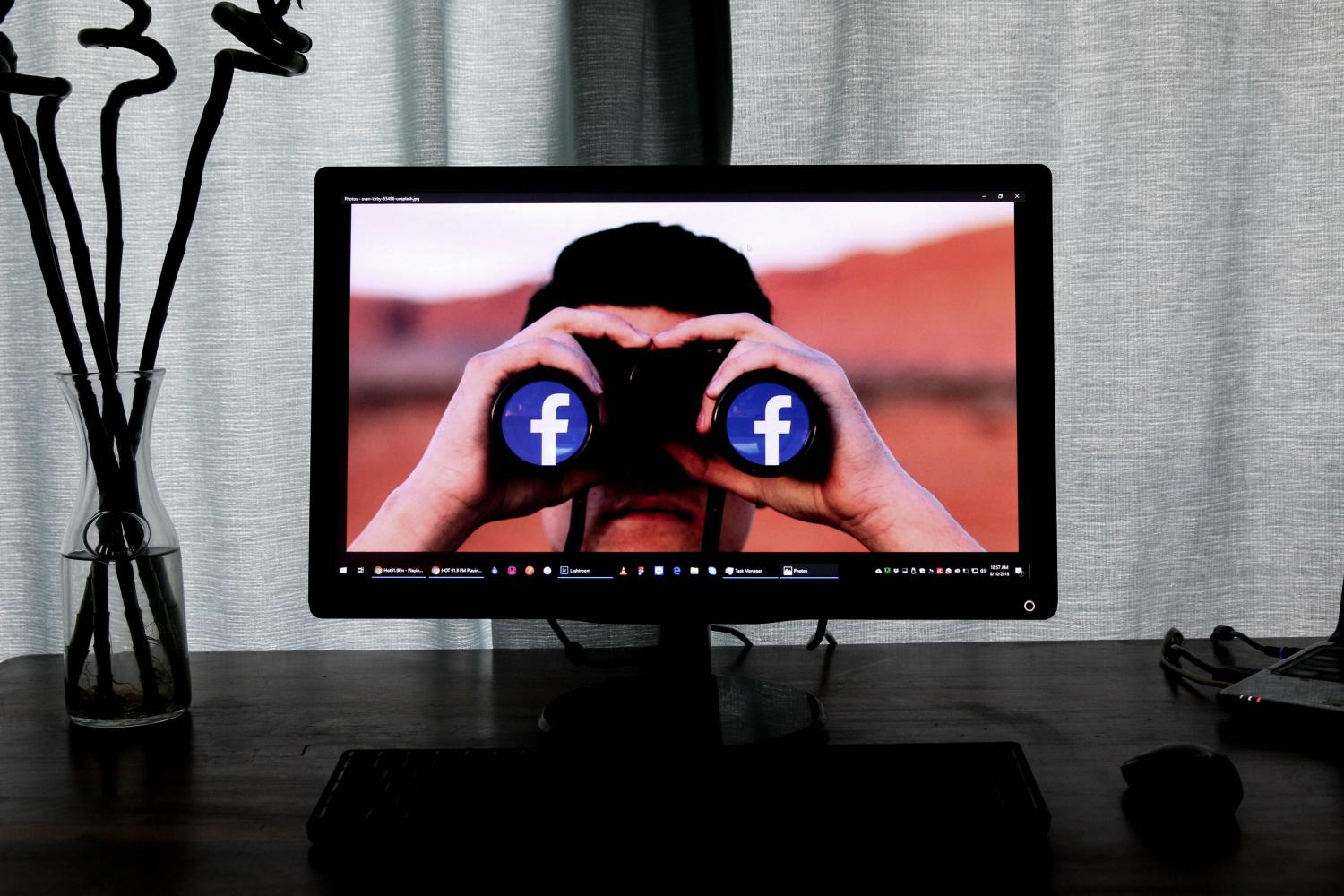Sports Leaders Come Together To Drive Impact Off the Field


Image: Lincoln Financial Field, home of the Philadelphia Eagles and host of the 2019 Green Sports Alliance Summit.
Sports have a unique ability to bring people together, and a growing number of the world’s largest sports franchises are leveraging their influence to make an impact off the field. The Green Sports Alliance catalyzes many of these efforts around sports and sustainability. Its membership includes hundreds of teams, leagues, venues and other industry stakeholders from around the world, who share best practices around improving operational efficiency and engaging fans.
“There's this massive power in sport that is unparalleled compared to other industries,” said Erik Distler, director of partnerships for the Green Sports Alliance. “We have an opportunity—frankly, I think it's a responsibility—to harness and leverage that power to advance broader environmental and social issues that are bigger than the game.”
Pushing for sustainability in sports
In December 2018, sports leaders came together with the United Nations to launch the Sports for Climate Action Framework—which challenges industry stakeholders leverage sports as a "unifying tool to drive climate awareness" among the public.
The Green Sports Alliance launched its Playing for the Next Generation campaign in support of the Framework, calling on its members to join and to do their part to combat climate change. “We've worked hard to figure out how to latch onto the Framework and help propel it in North America,” Distler told us. Several North American members of the Alliance have already signed on, including the New York Yankees baseball franchise, the National Basketball Association (NBA), and sports and entertainment company AEG—which owns the Los Angeles Kings hockey franchise, among other teams and venues.
Playing for the Next Generation also served as the theme for the Alliance's annual Green Sports Summit, held last month at Lincoln Financial Field, the home of the Philadelphia Eagles football franchise. As the Summit's host team, the Eagles offer an example of what’s possible when sports takes sustainability seriously.
The Philadelphia Eagles put words into action
What began with an office recycling program back in 2003 has grown into a company-wide effort to reduce environmental impact and increase fan awareness of sustainability issues.
Lincoln Financial Field—known to locals as The Linc—is one of the most environmentally sustainable stadiums used in sport. It’s home to the largest solar power plant of any stadium in the world, constructed in partnership with NRG Energy, which supplies enough power for all of the Eagles’ annual home games and 40 percent of the stadium’s overall energy needs. The Linc also diverts nearly 100 percent of its waste from landfills through recycling, composting and waste-to-energy systems.
Beyond operational improvements, the Eagles are increasingly looking to engage their fans around sustainability. Still, while sports teams command a unique authority with their fans, franchise leadership feels it’s important to be strategic around sustainability messaging to avoid turning people off, said Norman Vossschulte, director of guest experience for the Eagles.
“As a sports team, you put on a show,” Vossschulte told us at the Summit. “Fans come to the stadium to be entertained. They don’t come to necessarily learn about sustainability, so we have to be careful how we message. We believe in connecting with our fans, but we try to do that in fun and organic ways."
Case in point: In partnership with plastics manufacturer Braskem, the Eagles created a closed-loop recycling system to collect plastic bottle caps and turn them into durable goods for use in the stadium. To drive fan engagement around the initiative, the team and Braskem constructed an eight-foot-tall replica of the Vince Lombardi Trophy, commemorating the Eagles’ Super Bowl LII win, made entirely from bottle caps.
It’s become a favorite spot for picture-taking in the HeadHouse Plaza fan zone, and it’s surrounded by messaging about plastics recycling. Braskem also made a dozen bicycles out of bottle caps, which its executives rode in the Eagles' annual bike race to raise money for autism research.
“With us, it's really an organic journey,” Vossschulte said. “We are constantly asking the question, no matter what meeting we sit in or what venture we’re launching: Can sustainability be a part of this? That helps us to constantly evolve.”

Image: These bicycles made from recycled bottle caps rode in an Eagles' bike race fundraiser to support autism research.
Driving collaboration for a sustainable future in sports
The Eagles were one of many franchises, leagues and venues to share their sustainability journeys at the Green Sports Summit. While sports are known for fierce competition, the power of teamwork is also very much a part of the game—and the Green Sports Alliance leans on this unifying sentiment to drive knowledge-sharing across the industry.
“Sports bring up something in your heart about competition, but also about collaboration,” said Roger McClendon, executive director of the Alliance. “When you're on the same team, wearing the same uniform and fighting for the same goal, there's nothing you won't do to support the team. That's where Green Sports has the power. It’s not just the NBA, it's not just the U.S. Tennis Association, it's not just NASCAR. It's all of us together.”
Along with rallying support for the Sports for Climate Action Framework, the Alliance serves as a learning platform to help members reduce energy, waste, and water usage and make their procurements more sustainable. But for McClendon, who took the helm of the Alliance in February after nine years as Yum Brands’ first chief sustainability officer, this is only the beginning. He often refers to operational changes as Sustainability 1.0—they’re commendable, but they’re essentially table stakes for sports companies seeking to be good corporate citizens.
The deeper, fan engagement piece—which McClendon dubs Sustainability 2.0—is a logical next step. “You start to think about the fans who come and engage and you realize, ‘This is bigger than just what's inside my stadium,’” McClendon explained. But his 3.0 vision ultimately extends even further, as the Alliance calls on industry players to make strategic investments that have a lasting impact in their communities.
“That's where you get significant change, but it takes a long time to see the impact,” McClendon told us. “What's pushing us in that area is kind of like the chase to get to the moon—if we have that level of focus, we can make it happen. [Sports] has the resources and the power to influence for good.”
This drive for continual improvement and collaboration is central to the Alliance's mission—and it helps members push forward into what is often uncharted territory, said Vossschulte of the Eagles. "Sustainability is not our native language," he told us. "We’re really good at speaking in the language of sports, but sustainability is something we have to constantly learn, and that means we have to share what we’re doing with each other and think about what’s next. That's where we need the [Alliance] to help us forge those relationships with partners in the industry to find new solutions, new endeavors and new destinations on this journey."
The 2020 Green Sports Alliance Summit will be held in Minneapolis at the LEED Gold Certified U.S. Bank Stadium, home of the Minnesota Vikings football team. It will mark the Summit's 10th anniversary and represent the push toward the 3.0 vision and beyond. You can learn more about the event here.
Images courtesy of the author and Keith Johnston/Unsplash
Paul Polman Still Striving to Secure a Sustainable World


Reports about the departure of Paul Polman have turned out to be premature.
True, it’s only been several months since Polman stepped down as CEO of Unilever after a decade leading the fast-moving consumer goods sector for a decade. But as discussed on several news sources including Bloomberg (which he has verified) Polman plans to be front-and-center in the global sustainability movement with the foundation of a group that he says will take on ongoing problems including climate change and poverty.
Details on how this organization, Imagine, with which Polman is joining forces including Valerie Keller and Jeff Seabright, are still under wraps. But with Polman on board, who has long stood tall as showing how business can serve as a force for good, we can imagine what Imagine could do on the environmental, social and governance (ESG) front.
Such an organization is absolutely needed considering all the challenges society will continue to confront in the coming decade. Polman’s track record stands tall when considering how corporate sustainability has evolved over the past decade. Consider the time when Polman first took the helm at Unilever. Back during the quaint time of the 2000s, most companies were focused on showing that they could be environmentally responsible – and trying do so while scoring a net positive for the planet and their companies’ bottom line.
But Polman was among the visionaries who understood that a sustainable planet meant that people had to be healthy, have access to economic opportunities and above all, be treated as human beings. Hence the laundry list (no pun intended, Domestos, Rinso and Surf brand managers!) of programs Unilever launched during Polman’s tenure, such as a Lifebuoy handwashing campaign in India.
Sure, such a campaign appears to some as self-serving, considering the financial benefits for one of the company’s most timeless brands. But the numbers are hard to argue with: evidence suggests the campaign reached at least a quarter billion people in India alone several years after the program launched. Any illnesses prevented, let alone lives saved, make the message of this campaign one that is difficult to criticize (In the end, Unilever claims the total number of people reached totaled over a billion people, and was achieved two years early). The bottom line is that Unilever has started to crack the code on how a business can be both profitable while mitigating harm to people and the planet. We’re not there yet, but Unilever’s actions have helped pave that road on which we can all move forward.
Unilever has been a game-changer in other ways as well – from striving to open more doors for women and challenging gender norms in its advertising. Noteworthy for a company that has made a mint selling sachets of cleaning and personal care products in developing countries, Unilever was among the first multinationals to shift toward a circular economy model – again a tall order. These programs lunched while Polman was CEO of Unilever – along with other programs focused on human rights, the challenges smallholder farmers face and transforming how tea is sourced.
But there’s more at stake than global sustainability when thinking about Polman’s new venture. There’s another message his work could send – as in redefining retirement and showing experienced and seasoned employees worldwide that their perspectives are still very much valued.
Image credit: World Economic Forum/Flickr
Dairy Industry Efforts to Market Milk to Teens Face Criticism


One would think that when it comes to positioning its product as “responsible,” the dairy industry would have it made. After all, milk is known for its wholesome and nutritious qualities and the world’s leading health experts recommend that everyone consumes it.
What could be controversial about getting teenagers to drink more milk?
Well, some health advocates are now criticizing the dairy industry for its push to expand milk consumption among teens by sponsoring coffee and latte bars in high schools.
Facing declining consumption rates of milk, the Florida Dairy Group is one of several regional groups around the United States trying to find new ways to market the beverage. Through it’s “Moo-Lah for Schools” program, the group funds freestanding coffee bars in high schools. Its website explains that the coffee bars are an opportunity for schools to “serve 8oz. of milk with 2 oz. of coffee and added flavorings that fit into your school wellness policy,” and to encourage “students that might not normally select milk with their school meals to consume milk.”
The U.S. Department of Agriculture, which sets rules for schools participating in its meal programs, says high schools can sell espresso drinks that are no bigger than 12 ounces, and that are made with fat-free or 1 percent milk.
In the Southwest, the regional dairy group Dairy Max, which represents more than 900 dairy farmers across seven states, has provided similar grants to schools for coffee programs through its” Dairy-4-Schools Moo-La-Tte” program. “Great for high schools, coffee bars create opportunities for students and school faculty to grab a cup at school instead of their local coffee shop!” says the program’s website.
The industry is also hoping the coffee bars will expand consumption of other dairy products such as smoothies, and encourages schools to offer other healthy a la carte items at the coffee bars such as oatmeal and salads.
Industry aims to increase milk consumption
The programs are the latest tactic by the industry to help dairy farmers reclaim consumers after facing nearly 40 years of falling consumption rates.
A report by the USDA found that since 1977, mean intakes of milk have decreased for children and adolescents. Among adolescents, the decline is particularly acute; the percent reporting milk consumption was 76 percent in 1977-1978, but only 48 percent in 2005-2006.
Health and nutrition advocates agree that milk provides protein, nutrients and vitamins, including vitamin D and calcium, critical to teens’ growing bodies. In fact, they recommend that teens drink three cups of milk each day.
Health advocates raise concerns
As a parent who struggles to get her own teenage daughter to drink milk, the school programs seem innovative and helpful. But not everyone agrees that the dairy industry should be lauded for its efforts to support the nutrition of America’s teens.
Critics claim that the new coffee cafés will create a population of over-caffeinated kids and that there are other ways to increase dairy intake.
The American Academy of Pediatrics discourages caffeine consumption among children and adolescents, citing potentially harmful effects on developing bodies. And while dairy is an efficient way to get calcium and vitamin D, it’s not the only way to get such nutrients, Dr. Natalie Muth, a pediatrician and representative for the American Academy of Pediatrics, told the Associated Press. Muth added that there are ways to encourage students to get the nutrients of milk without promoting caffeine habits that could lead to headaches, agitation and lack of sleep.
Muth has a valid point, but is it realistic to attempt to eliminate all caffeine from today’s teens’ diets? With energy drinks of dubious claims continuing to explode on the market and vending machines full of sugary drinks, is one 12-ounce latte really that terrible of an alternative?
Image credit: Tye Doring/Unsplash
Cost of Rooftop Solar Power Set for Another Steep Plunge


Rooftop solar arrays can be a valuable asset for businesses seeking clean power, and new financing tools make it easier than ever to avoid up-front costs. However, the process of buying a rooftop solar array can still be intimidating. It is not unusual for solar customers to lose interest after their project gets bogged down by long processing times for permits, inspections and grid connections.
That’s about to change, if the new “SolarApp” program goes according to plan.
What’s keeping the cost of rooftop solar up?
For solar installers, the processing issue is more than a simple matter of losing customers. The installer also loses money on advertising, outreach and other administrative costs.
Those costs end up being reflected in the price paid by other clients. In other words, everyone pays.
The impact on the cost of rooftop solar is a significant one when multiplied across the U.S. solar industry. Administrative “soft costs” make rooftop far solar more expensive in the U.S. than in other countries with a mature solar industry.
According to the Energy Department’s National Renewable Energy Laboratory, soft costs tack thousands of dollars on to the total price of an installed rooftop solar array in the U.S.
Some of those costs could be avoided by streamlining the permitting process, and that’s where SolarApp comes in.
Rooftop solar made easy: there’s an app for that
SolarApp stands for the proposed “Solar Automated Permit Processing” software platform. Spearheaded by leading solar industry stakeholders, the campaign to create SolarApp addresses to the heart of the problem. More than 20,000 different authorities in the U.S. have jurisdiction over different elements of rooftop solar installations. That includes permits, inspections, application fees and grid connections.
The SolarApp campaign seeks to streamline the process for residential, commercial, and industrial rooftop solar into a single, nationwide online portal that includes federal, state, and local authorities.
In contrast to a process that can take months, SolarApp aims at practically “instantaneous” approval for most routine solar projects. The campaign also seeks to create national standards for safety and quality, and it also accommodates the growing popularity of solar systems paired with energy storage.
Who wants to cut the cost of rooftop solar?
There is some heavy firepower behind the campaign to bring SolarApp into being.
Last week, the U.S. Energy Department of Energy assigned an award of $695,000 to its National Renewable Energy Laboratory (NREL) to help get SolarAPP off the ground.
NREL will function as an independent, third-party software developer for the solar industry. The non-profit Solar Foundation is an ongoing partner of the Department of Energy, and it will spearhead a an industry stakeholder group that includes the Solar Energy Industries Association, the California Solar + Storage Association and the Institute for Building Technology and Safety - along with the leading solar installers SunPower, Sunrun, Tesla and Vivint Solar.
The effort could also get a boost from scores of U.S. cities that are involved in SolSmart, another Energy Department-Solar Foundation partnership that encourages local governments to speed up the processing time for solar permits.
Why rooftop solar is still a good deal, soft costs or not
Even without SolarApp in hand, a growing number of U.S. businesses can easily access solar through a clean power option provided by their utility.
Still, a rooftop solar array provides benefits that can’t be matched by a line item on a utility bill.
Although initial up-front costs are relatively high in the U.S., a rooftop solar array can still save money over its lifespan. In contrast, utilities can charge a premium for clean power.
When paired with energy storage, the benefits of rooftop solar multiply. Storage systems can cut the payback period down by years. They also provide businesses with access to zero emission backup power in emergencies, and they create more opportunities to avoid peak demand charges and participate in other “smart grid” initiatives.
Businesses with excess solar capacity on their roofs can also take advantage of opportunities to sell or share their clean power with the community.
The visual impact of rooftop arrays
Above all, rooftop solar panels also form a powerful, high-visibility demonstration of a business’s commitment to climate action.
That’s important from a bottom line perspective because evidence is growing that public opinion favors clean power regardless of partisan political affiliation. Climate change is a growing concern among younger adults, a key advertising demographic.
A recent Deloitte study underscores that businesses can — and should — respond to consumer expectations for clean power.
Deloitte found that consumers still tend to waffle on rooftop solar because they are intimidated by the process. In contrast, businesses are aggressively pursuing it.
With or without SolarApp, there are plenty of good reasons for commercial ratepayers to go solar.
Image credit: Biel Morro/Unsplash
Why Amazon’s Long Island City Plans Should Have Considered Climate Risk


When Amazon was turned away from its Long Island City dream by angry New Yorkers, the company narrowly skirted a bigger issue – the impact of a climate change event that even Amazon is not big enough to get away from.
After all, it’s called Long Island for a reason: in the event of a volatile weather event such as a superstorm, evacuation of all of those working folks whose welfare about which local protesters were so concerned would have been tough. They would all have had to traipse through Manhattan or Connecticut to get out of harm’s way (with much of Manhattan and Connecticut’s populations traversing the same terrain).
Considering that Amazon is planning to be around for the long haul, it seems prudent to look at climate risk criteria in their site selection. Settling down in a place that will likely be partially underwater by 2050 is not prudent. But with all the other risks that companies need to evaluate, what to do about this relatively new vector?
In the U.S., corporate risk managers should turn to free open source tools like the Urban Adaptation Assessment (UAA) created by researchers at the University of Notre Dame. Faster than you can select your kid’s college comforter on Amazon Prime, you can see climate vulnerability assessments, data and graphics for 270-plus cities that will inform these critical decisions. For each city, UAA provides metrics for vulnerabilities related to flooding, extreme heat, extreme cold, drought, and sea-level rise, as well as the city’s readiness to adapt.
While Amazon evaluated measures like a metro area of more than one million people near an international airport with a stable and business friendly environment where there is potential to attract strong technical talent, they missed this risk that investors and global leaders are increasingly working into their decision making.
For a risk manager that gets push back that climate risk is something the firm can build its way out of, offer up that that is true – asset level resilience can be bought. But recall that those new soaring office and hotel buildings in South Boston’s Seaport District (where Amazon is expected to house 2,000 workers) with their inflatable and storable sea walls were no match for the March 2018 Nor’easter that surged onto streets throughout the seaport. By the way, UAA gives Boston good scores for its existing adaptive capacities but notes a flood event there could cost upwards of $1.5 billion.
So what about Amazon’s Northern Virginia metro area choice? Using NOAA sea-level rise projections, the Urban Adaptation Assessment makes plain that the District of Columbia could expect a 1.2-foot inundation along the Potomac in 2040 with costs approaching $155 million per foot of sea level rise. For Alexandria, the Potomac and other waterways could rise as high as a foot, with damages up to $25 million.
And Amazon is not the only one who cares about its risky choices: the Task Force on Climate Related Financial Disclosure’s 2019 Status Report shows a steady increase in the number of investors taking the physical risks of climate change into consideration in their decision making. Michael Bloomberg, a former mayor, investor, business owner and climate activist, as well as the co-lead of TCFD, points out that assessing climate risks means that “businesses are better informed about the risks they face, and investors are more capable of making sound decisions.”
In the fickle investment marketplace, accounting for and acting to avoid the worst of climate risk beyond physical assets to your strategies and operations is likely to bring competitive advantage. That would be an Amazonian move.
Image credit: Darin Kim/Flickr
What Solutions Exist for a ‘Toxic’ Workplace for Content Moderators at Facebook?


Humans with help from artificial intelligence have been enforcing Facebook’s community standards to ensure its 2.3 billion users do not interact with disturbing content. These 15,000 contractors who view videos of animal torture, beatings and more of humanity’s most horrific acts on the world’s largest digital community so users don’t have to watch are now bringing attention to the dark realities of their jobs.
Over the past year, these content moderators have taken different actions – including issuing lawsuits and breaking their non-disclosure agreements to share their stories with the press to highlight the grueling culture as they strive to make their case for better pay and workplace conditions.
In a recent feature published on the Washington Post, a group of content moderators who work within an Accenture site in Austin issued a letter on an internal Facebook forum. The letter described the poor morale in their workplace due to a sense that they could be easily replaced, the jobs' low pay and strict production quotas.
How Facebook is reinventing this toxic work environment
Facebook claims that it currently provides pre-training for all content moderators so they know how to access wellness support and ongoing coaching. The company says it also has a team of clinical psychologists who design and evaluate resiliency programs for all content moderation centers – as stated in Facebook’s blog.
The social network says it also plans to raise contractors’ hourly wage globally – including from $15 to $18 in Austin and from $20 to $22 in northern California’s Bay Area by the summer of 2020. Meanwhile, the company insists it is expanding on-site counseling for all hours of operation and developing a tool for content moderators to blur disturbing images before they review the material.
“We have to run a very large-scale platform. We have to take care of the community. And that means we have to get a whole lot of work done,” Arun Chandra, the company’s vice president of scaled support, told The Verge, “but that is not at the expense of [contractors’] well-being.”
Moderation is critical to Facebook’s brand reputation
To secure its position as a leader in the technology space, Facebook must answer its own question about how to foster a safe community for its content moderators so the company can deliver on its brand’s mission to build community. Since Facebook’s moderators put the brand’s values of globalization and connectivity into action, they are critical to Facebook’s positioning as the company to bring communities from around the globe together.
“The fundamental reason for content moderation – its root reason for existing – goes quite simply to the issue of brand protection and liability mitigation for the platform,” explained Sarah T. Roberts, an assistant professor at UCLA who studies commercial content moderation.
“It is our job at Facebook to help people make the greatest positive impact while mitigating areas where technology and social media can contribute to divisiveness and isolation,” wrote CEO Mark Zuckerberg in a 2017 blog.
How can Facebook mitigate the harsh realities of humanity to preserve its legacy and uphold democracy without harming thousands of contractors’ mental health?
What are viable ways to reinvent a toxic work environment?
One way Facebook can reinvent the toxic moderation environment is by hiring these content moderators as full-time employees, rather than as contractors. The result would be employees who had more affordable healthcare (and perhaps most importantly, access to mental health professionals), and would also be able to take time off for any reason without losing pay. A counter-argument to such a policy, however, would be that the scaling of such a solution would require huge sums of cash that would otherwise be used to retain talent in other areas of Facebook’s business.
Another option the company could consider is to continue paid counseling sessions and other mental health services post-employment at Facebook for a certain length of time. Since some content moderators have reported PTSD symptoms and drug use, such long-term services would allow for a safer transition after their tenure at Facebook, continuing to their next jobs. In the end, employees would have access to longer and better well-rounded treatment.
Both solutions could come across as band-aid approaches, and would not stop thousands of contractors from watching traumatic videos day in and day out to create a safer Facebook community. Is it possible for Facebook to reinvent its strategy for fostering a safe global community that negates content moderation all together without closing its doors? What do you think?
Image credit: Glen Carrie/Unsplash
This Program Gives Bees Independence from Environmental Degradation

In a state full of incredible scenery, one route that shouldn’t be missed in California is Highway 20, which takes you through the Mendocino Range west into Fort Bragg. Redwoods that pierce the sky eventually recede as you enter Fort Bragg and arrive at the spectacular Mendocino coast. Among the many reasons to visit, this town of 7,000 is becoming a haven for pollinators, due in part to its participation in the Bee City USA program, a Xerxes Society initiative.
Fort Bragg became the first California city to participate with Bee City USA three years ago. Cities, towns and counties that join the program make various commitments to raise awareness about the role pollinators have in our food supply, as well as the development of habitats that attract the likes of bees, butterflies, bats and hummingbirds. Cities that align with this movement are encouraged to develop teams that include local environmental leaders, municipal employees and experts well-versed in how to boost local populations of pollinators.
Nationwide, the Bee City program includes Duke Energy and the information technology firm DelCor as sponsors. Local supporters in Fort Bragg include a local coffee roaster, which has marketed one coffee blend in a partnership with the NGO Friends of the Earth to help raise funds for projects designed to create ecosystems that can help pollinators thrive locally. The results have included a bee garden at one of the city’s central attractions (the historic Guest House Park, shown above), as well as educational programs in surrounding Mendocino County.
Bee City USA is still at a nascent stage, and could certainly benefit from more awareness and corporate support. The challenge is huge: research published in the journal Biological Conservation earlier this year concluded that over 40 percent of insect species worldwide are confronting the risk of extinction over the next few decades. Another study published in 2017 suggested that there has been a 75 percent loss of insect biomass since the 1980s. Rampant overdevelopment, the use of pesticides, increased diversion of land to farming and of course, climate change are among the reasons the plight of pollinators has surged from a problem to crisis across much of the world.
(photo above: California poppies along the Mendocino coast)
The drive to save pollinators certainly offers a compelling reason for cities, with local business support, to align with the Bee City USA movement. But there are other reasons to become a Bee City – including another boost for local tourism as well has providing more aesthetics to a town’s central core and surrounding neighborhoods. Walking along the town’s main drag along Highway 1, Fort Bragg benefits from the pops of color resulting from its drive to revive local bee populations. Varieties of lavender, lilacs, poppies, sage, goldenrod and Mendocino Coast Indian paintbrush complement the town’s historic buildings. Locals, visitors and pollinators all win.
Image credits: Leon Kaye
Investors Are Taking a Stand for Workplace Equity


Over 56 years after the Equal Pay Act was passed, women still earn as little as 49 cents to the average man’s dollar, and only 33 female CEOs are represented in the Fortune 500—an underwhelming 7 percent.
These figures are symbolic of a work landscape that often fails to equitably pay and promote the historically disadvantaged: women, people of color, minority communities and older adults, to name only a few.
Investors are noticing the deleterious effects of inequity in the workplace and are taking a stand for their bottom lines. As of press time, at least 99 investors have signed a “Workplace Equity Disclosure Statement,” demanding that companies release data about their diversity and inclusion policies and practices.
According to the shareholder advocacy group As You Sow, Equileap is sending the statement to over 3,000 companies across 23 developed market economies..
For the investors, currently representing more than $1.61 trillion in assets under management, the hope is to make better-informed decisions about their holdings. History has shown that companies that fail to attract and sustain diverse employees and leaders are riskier investments, meaning the return is not guaranteed.
Diversity and inclusion are matters of money
Yes, a diverse and inclusive workplace is a happier workplace, but investors and companies don’t have to be altruistic to invest in equity.
Research from the consulting firm McKinsey & Co. shows that companies with gender and ethnically or culturally diverse leadership teams are significantly more likely to financially outperform their competitors. Additionally, being in the bottom-quartile of diversity means a company is 29 percent less likely to achieve above-average profitability.
In studying 17 leading companies, McKinsey found that more diverse companies are better positioned to attract top talent, to improve employee satisfaction, to secure their license to operate and more.
If diversity pays, aren’t companies catching on?
Not quite.
While many companies include the word 'diversity' somewhere in their mission statements or values, the reality is often lagging.
Most company executives want to bring in a diverse cohort, but they don’t understand the policies and practices that go into genuinely welcoming and sustaining underrepresented workers.
Data is essential. Employees who feel different don’t volunteer how they are thinking on their own. This concealment is called “identity cover” in the diversity and inclusion community. To compensate, companies must collect thorough, segmented data from employees to understand how to create an environment that works for everyone.
The unfortunate reality is that 400 of the companies on the Fortune 500 list share no data about the gender or ethnicity of their employees, and only 3 percent release complete data.
It is clear that companies are not yet taking diversity seriously as a tracked goal.
Transparency is key for workplace equity
Even when it comes to gender alone, company policies are lagging, and transparency is found wanting.
According to Equileap’s report, Gender Equality in the U.S., American companies scored a C- on gender equality—a grade that is calculated based on 19 criteria, including categories such as paid leave for child care, compensation and work-life balance.
In the report, transparency was a problematic area. Many companies do not publish data on the health plans they offer, which makes it difficult to know what they provide for reproductive services and family planning.
Additionally, only one company in the S&P 100 Index publishes gender-segregated pay information.
If companies didn’t previously know to collect data about their practices and employees and to publish them, they should now. Investors have spoken; they can no longer ignore the impact of diversity and inclusion.
The investors’ Workplace Equity Disclosure Statement asks for access to information about policies and practices across federally-protected classes such as gender, race, ethnicity and sexual orientation.
Some companies are taking their own stand
Also in June, 72 CEOs signed an Equity Pledge, vowing to fill half of meaningful leadership roles with women by 2030. To aid in sustainable growth, companies are also committing to the Equity Principles that The Chicago Network—an organization of Chicago’s influential female leaders and the creator of the pledge—has defined:
- Remove barriers
- Define success
- Evolve culture
- Enhance community
- Maintain accountability
Data is key to inclusion, and The Chicago Network will monitor the companies’ progress every other year over the next 10.5 years by collecting quantitative data, as well as anecdotal information about what’s working for female employees and what’s not.
That is just the tip of the iceberg for The Chicago Network’s aspirations to support female leaders.
The signers of the pledge currently include 10 public companies, 23 private companies, 27 nonprofits, 10 associations and two government entities. The Chicago Network will continue to invite companies to sign this year, with the goal of 100 signatories.
Are you a Chicago business? Take the pledge.
An investor’s signature is worth more than words
With a little nudge from investors (and even outside organizations and consultants) businesses can elevate their culture, programs and policies to be more inclusive—and more profitable.
Are you an investor interested in standing for diversity and inclusion? Sign up for the Workplace Equity Disclosure Statement.
Image credit: Christina Morillo/Pexels
Act Locally: Israel’s Maala Shows How National Standards Can Move the Needle on Global CSR


Image: Maala releases its 2019 CSR Index at the Tel Aviv Stock Exchange on July 2.
This article series is sponsored by Maala and produced by the TriplePundit editorial team.
Global reporting systems have become a mainstay of major multinational companies seeking to track their progress on human rights and environmental impact. However, some companies may benefit from a more detailed accounting that focuses on national issues. Maala, Israel’s corporate social responsibility (CSR) standards-setting organization, shows how a nation-based CSR rating system can help companies balance global priorities with what’s happening in their own communities.
The power of nation-based metrics
As we often report here on TriplePundit, investors are increasingly interested in companies’ CSR performance. Globally, sustainable and socially responsible investing now represents more than $1 in every $4 under professional management, according to the Global Sustainable Investment Alliance.
The impact of global indices like the Dow Jones Sustainability Index are well recognized: They serve as a stamp of quality for investors and help companies see how they stack up compared to their competitors. Nation-based indices are less recognized and used. In Israel, Maala shows how nation-based data can help companies—particularly those that are large in their local market but have limited or no international operations—apply global sustainability and CSR standards locally.
A nonprofit corporate networking organization founded in 1998, Maala publishes the Maala CSR Index annually on the Tel Aviv Stock Exchange (TASE). Based on the research this rating provides, the TASE offers three sustainability indices for investors, which represent about 50 percent of the total market value traded on the exchange.
The nonprofit first developed the rating 15 years ago and continues to update the criteria, which is now recognized as the voluntary standard for CSR in Israel. Released on July 2 at the TASE, the 2019 Maala Index includes 161 companies that receive the highest marks from Maala on CSR and sustainability.
Leveraging corporate culture
Maala’s corporate network comprises 120 companies, including leading Israeli companies, as well as multinationals with operations in Israel. Maala CEO Momo Mahadav cites Israeli corporate culture as a key factor in developing the index, which can be both a challenge and an opportunity.
“A lot of major ratings and sustainability analyses have been done in Europe and the United States, where most of the major players are multinational companies,” he explains. “Companies this size are somewhat different than a nation-centered company, in terms of their internal procedures and management systems.”
Specifically, Israeli companies tend to have leaner corporate headquarters than global firms, Mahadav explains. Without excess layers of staff as a cushion, executives at Israeli companies may be more directly exposed to local issues that can have an impact on their progress toward their sustainability goals.
Zeroing-in on diversity
That closer connection with local issues is reflected in Maala’s approach to rating Israeli companies on CSR—particularly when it comes to diversity and inclusion.
Diversity is a foundational challenge for most businesses and is especially fraught in Israel. Ratings based simply on numerical percentages—in other words, the number of women or underrepresented groups employed by a company—only address a fraction of the issue.
To be truly inclusive, Israeli companies cannot focus only on quantity, Mahadav explains. They also need to develop internal processes that enable people of all backgrounds to make progress in their careers—and work like this cannot be measured by numbers alone.
By providing space for qualitative benchmarking, the Maala index allows companies to see beyond short-term, quantifiable gains and focus on the long term. “Even organizations with vast diversity efforts may occasionally find it difficult to gain 'quick wins,’ and it may take a number of years until the change they've initiated will show,” explains Tal Yallon, former executive director of the Israeli Forum for Employment Diversity. “As [the Maala index] examines both quantitative and qualitative performance, it enables companies to measure their performance internally throughout the process.”
The index also serves as motivation, allowing companies to benchmark against their peers on best practices that reflect “the current bar that companies should aspire to,” says Yallon, who was recently succeeded by Noa Tron as executive director of the Forum.
Setting the bar for CSR
As for how to set that bar, Maala looks beyond its network of business stakeholders to assemble an independent committee of volunteer experts, which updates the CSR index on a continual basis. Included in the committee are members of academia, non-governmental organizations and government agencies, as well as leaders in the business community.
“It is a mechanism that defines the consensus as to what is required from a company that is committed to sustainability and CSR,” Mahadav says of the committee. “It is a powerful mechanism, and it enables other stakeholders to come forward with issues they feel are urgent and relevant, in Israel and globally.”
To be considered for inclusion on the index, companies fill out questionnaires reflecting both their negative and positive impacts on people and the planet. These surveys address not only global issues, but also “areas that complement priorities in Israel,” Mahadav says, allowing companies to put a greater focus on their local impacts. “Most global questionnaires won’t go into those kinds of details,” he adds.
The next Maala questionnaire, for example, includes a comprehensive new chapter on employees—with a focus on reporting metrics related to social mobility, especially for employees in entry-level positions. The new chapter also covers broader social issues like in-work poverty and inclusive growth, and it looks ahead to the impact of foundational trends like automation, increased lifespans and careers after retirement.
Next steps for progress
As demonstrated by social conflict in the U.S. and elsewhere, progress is more like a maze than a stepladder—peppered with dead-ends and circular pathways that can keep the end goal out of reach for generations. Nation-based reporting systems offer an important tool for accelerating change. By putting broad-sweeping global efforts in a local context, rating systems like Maala’s help companies identify areas where they’re best positioned to drive impact in their own communities—efforts that, in turn, support the global push for sustainability and social equity.
As a nation-based reporting system, the Maala index provides Israeli companies with a forum for competing with one another and claiming hometown glory within their own “club,” as well as on a global stage.
In other words, the Maala index gets to the heart of human nature and our drive to compete not only on a global scale, but also within a community. “Elevating local standards is the primary goal,” Mahadav concludes.
Image credit: Ilan Spira
A Cheeky Response to Plant-Based Foods: Arby’s 'Marrot'


Arby’s, the quick-service sandwich chain that proclaims, “We Have the Meats,” recently unveiled a creation that is so controversial yet so brave: the Marrot, a carrot made of meat. The “meatable” begins with turkey breast that is sliced and sculpted into carrot shape, rolled in cheesecloth and plastic wrap, cooked sous vide, covered in carrot juice powder, and roasted for an hour. A sprig of parsley is added for a final touch. It’s Arby’s way of sticking to its guns while its competitors pivot to the flexitarian wave in consumers’ eating preferences.
This strategy saved Arby’s in the past and has paid off since; in the face of flexitarians and plant-based meats, it may be the essential ingredient to keep this meat-focused brand strong.
At the end of 2008, sales at Arby’s had fallen 5.8 percent from the previous year; the following year sales were down another 8.2 percent and continued to fall a whopping 11.6 percent in the first quarter of 2010. Desperate attempts to bring customers back included $1 menu options. This low-cost strategy backfired, yielding the lowest profit margins to date. The underlying disconnect between Arby’s and consumers couldn’t be fixed with budget-friendly options. It wasn’t until Wendy’s sold its stake in Arby’s to Roark Group that the company was able to address what was then its weakened brand.
Newly-placed executives focused on strengthening what had historically worked for Arby’s and ditching what didn’t. The brand succeeded when it delivered innovation and quality meats, which became the core of Arby’s revival. According to the company, over 1,000 new recipes are tested by Arby’s every year, creating some memorable sandwiches featuring brisket and even venison. While this hyper-meat focus may have turned some customers away, it worked for those who love meat. Sales grew and, by 2016, Arby’s was renovating and opening new locations for the first time in years.
Arby's Marrot is a signal that the chain is determined not to fall into a lull yet again.
Those repelled by Arby’s meat-centric menu may at least be attracted to the personality of the brand. When the company became the target of multiple roasts by Jon Stewart on The Daily Show, it responded with the same deprecating humor. After Stewart retired from hosting the show, Arby’s reached out over Twitter and invited him to apply for a job at their restaurants. This humorous approach to attacks on the brand—whether it be from Jon Stewart or vegetarians—has become a part of Arby’s identity.
The Marrot sends a clear—or, could we say, meaty—message on where Arby’s stands in the plant-based meat wave. While Burger King, Red Robin and other fellow fast-food chains partner with Impossible Foods and Beyond Meat, Arby’s stays true to brand. The Marrot combines humor with innovation and meat, a recipe that has consistently worked for Arby’s. It may not be for everyone, but neither is Arby’s.
Image credit: Inspire Brands